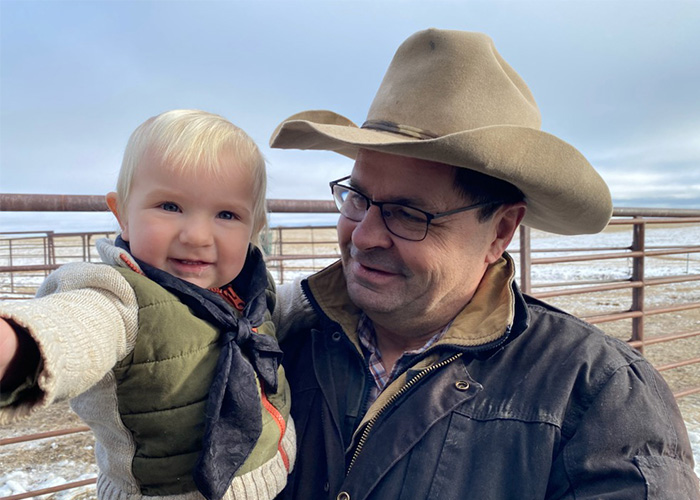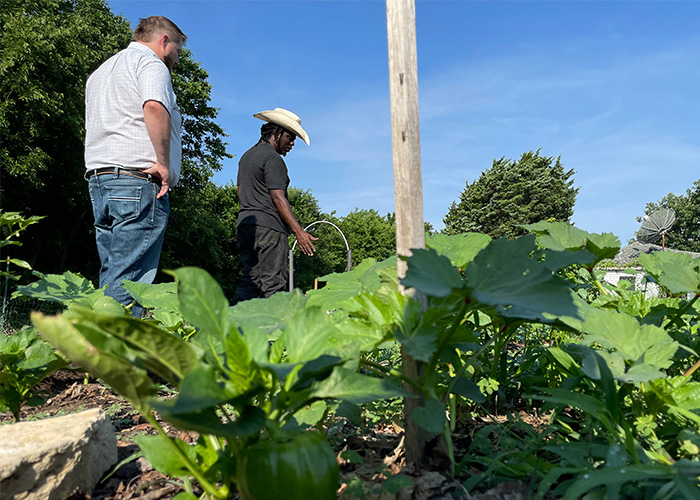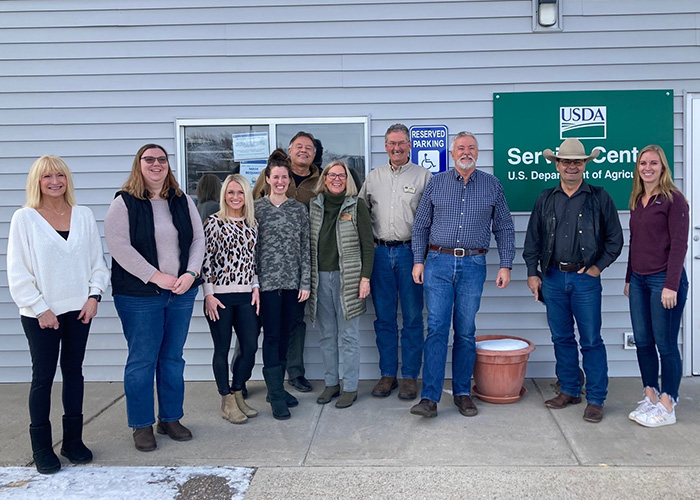Effective beginning 5/20/2025: Please note this site is under review and content may change.
While I was home a few weeks ago, I got to help the crew work their cows and wrap up another production year. When we do our fall work preg-checking with our cows, like many of you, we typically take the opportunity to reflect on the year, contemplate the future.

I don’t need to tell you that oftentimes that future holds uncertainty. We have the good fortune at the FSA to continue to help producers navigate some of those uncertainties. The programs we offer can often be the best news possible for a producer living in that uncertainty. In 2023, investments from our programs made positive impacts on the lives of many agricultural producers, including those experiencing distress or those picking up the pieces after natural disasters — investments that will pay dividends for many years to come.
Our dedicated employees delivered more than $16.9 billion in farm programs and farm loans throughout the year. Some noteworthy accomplishments included helping distressed borrowers, improving our processes and programs, and providing support to our producers in times of hardship. These accomplishments were borne out of our concerted effort to approach our policies and programs with fresh eyes, creative ideas and a common purpose guided by the goal of fairly and equitably delivering the most assistance to the most producers possible.
We’re proud of our work in 2023, and our efforts to support our nation’s farmers and ranchers complement the hard work of the Biden-Harris Administration over the past three years.
Loan Assistance for Producers through the Inflation Reduction Act
As of December 2023, we have helped more than 34,000 financially distressed farmers and ranchers stay on their family operation, thanks to resources provided through Section 22006 of the Inflation Reduction Act. Since the law was signed in August 2022, producers have received approximately $1.9 billion and counting in immediate assistance from the available $3.1 billion. This is the first step in a series of more comprehensive programmatic reforms that are intended to help our farmers create resilience. Stay tuned in 2024!
Through the Increasing Land, Capital, and Market Access Program we selected 50 innovative projects worth approximately $300 million. These projects will help improve access to land, capital, and markets for underserved farmers, ranchers, and forest landowners. This program was also funded by the Inflation Reduction Act as part of a broader investment to help ensure organizations representing underserved producers have the resources, tools, programs, and technical support they need to ensure producer success.
To better serve urban farmers, USDA established 17 new Urban Service Centers in 15 states in 2023. These service centers are staffed by FSA and Natural Resources Conservation Service employees offering farm loan, conservation, disaster assistance, and risk management programs. Additionally, we established 10 new urban county committees to help local administration of FSA programs in urban areas. To strengthen the Urban Service Centers and urban county committees, USDA is investing $40 million, made possible by President Biden’s American Rescue Plan, into partnerships with community-based organizations to provide outreach, training, and assistance to producers.

Program and Process Improvements
I’ve heard about the “stack of papers” and the “decisions that take forever” with regard to our loan programs for years. This year we cut the loan application from 29 to 13 pages, which has already dramatically reduced the time it takes to apply for a loan. We recently announced an online, interactive, guided application that simplifies the direct loan process for the more than 26,000 customers who apply each year. FSA also launched the Application Fast Track Pilot Program that uses financial data to reduce loan application processing times for those who meet certain benchmarks. This pilot program will be available nationwide in 2024 and has already demonstrated success in reducing review time for staff and producer alike.
To ensure producers can take advantage of the important improvements to our standing disaster programs, we waived the requirement to submit notices of loss within a pre-determined number of days for the Emergency Assistance for Livestock, Honeybees, and Farm-raised Fish (ELAP) and Livestock Indemnity Program (LIP) for 2023 and simplified the application process for underserved producers to obtain Noninsured Crop Disaster Assistance Program coverage for eligible crops. We also expanded eligible livestock under ELAP, LIP, and the Livestock Forage Disaster Assistance Program, and increased the LIP payment rate for beef, beefalo, bison, and dairy animals less than 400 pounds and, most recently, beef calves over 800 pounds.
Receiving funds from USDA through conservation program payments or disaster programs is considered farm income that includes a tax liability for farm businesses. Navigating filing taxes can be challenging for farmers, especially if they are new to running a farm business, participated in disaster programs for the first time, or are trying to forecast their tax bill. To better support the producers we serve, USDA has partnered with tax experts from across the country to connect producers to information and resources related to USDA program payments, asset protection, and the important relationships between federal income taxes and USDA farm programs.
We began the rollout of the FSA Customer Kiosk devices, which will be available in all service centers by April 2024. The Customer Kiosk program enhances the customer experience and reduces the paperwork burden on customers and staff alike. Some functionality of the devices includes reviewing and signing electronic documents, browsing FSA’s large library of programs and resources, and accessing helpful third-party resources. The devices add a 21st century method to doing business with FSA, which has been long awaited.

Emergency Relief, Disaster Assistance and Safety-Net Support
American agriculture was impacted by multiple natural disasters and weather events in 2023, including widespread drought, tornadoes, wildfires, and winter storms. Through FSA’s suite of disaster assistance programs, such as the Livestock Forage Disaster Assistance Program and Emergency Conservation Program, producers received more than $5.3 billion to help offset 2023 calendar year disaster-related losses.
Additionally, FSA provided more than $2.4 billion in 2023 through the Emergency Relief Program and Emergency Livestock Relief Program to assist crop and livestock producers who suffered losses due to qualifying natural disaster events in 2020, 2021 and 2022. FSA was able to provide the most assistance possible to 82% of impacted producers in spite of funding that met approximately one-third of the need, further honoring our mission of keeping farmers farming.
We also established the Milk Loss Program in 2023 to help offset economic loss by producers left with no other choice but dumping their milk due to disasters during those years. These producers continue to face supply chain issues, high feed and input costs, labor shortages, and market volatilities. In 2023, dairy producers received more than $1.2 billion through the Dairy Margin Coverage Program, which triggered payments 11 months of the year.
Climate Smart Agriculture
Since 2021, USDA has seen a significant increase in enrollment and interest in its Conversation Reserve Program (CRP), which is a critical part of the Department’s efforts to support climate-smart agriculture and forestry on working lands. In October, USDA announced it issued more than $1.77 billion to 667,000 agricultural producers and landowners for 23 million acres of private land enrolled in CRP. This includes the 2023 enrollment of 927,000 acres in General CRP, 2.3 million acres in Grassland CRP, and 694,000 acres in Continuous CRP. I’m very proud that we’ve continued to improve and expand CRP over the past several years―in 2021, we introduced higher payment rates, new incentives, and a more targeted focus on CRP’s role in climate change mitigation. We also renewed our emphasis on partnership programs, including the Conservation Reserve Enhancement Program additional staff and working to improve the flexibility of the program.
By this point in the blog, you know that our accomplishments are many but I’m sincere when I say that our successes are yours — each program, policy, and deployment decision is made with your best interest in mind because we understand that getting it right, or making it right, impacts your livelihood and way of life.
These investments and enhancements taken on their own merit are tremendous. When considered in the context of the “All of Department” approach Secretary Vilsack has led to create and improve income streams to producers and rejuvenate our rural economies we can once again see a future for the next generations in this work. The Biden-Harris Administration will continue to build on these successes in 2024, and we’re excited to continue to serve our producers and listen to your solutions on how to make the most out of our investments in Rural America.
Zach Ducheneaux is the Administrator of USDA’s Farm Service Agency. He can be reached at zach.ducheneaux@usda.gov.


